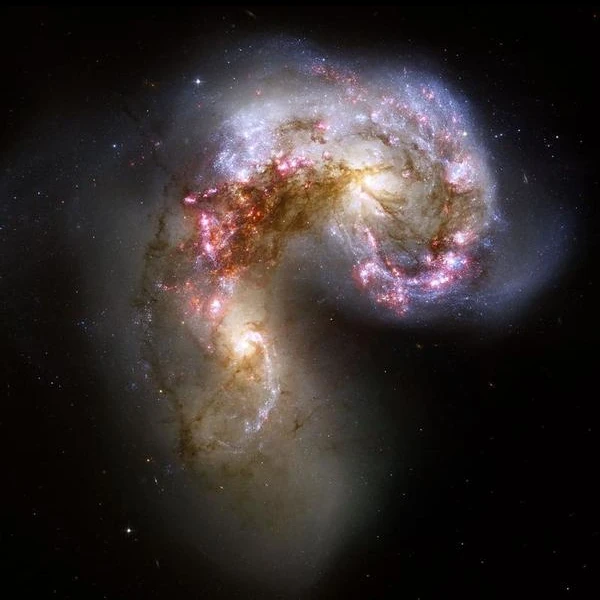
The Antennae Galaxies, known as NGC 4038 and NGC 4039, are located in the constellation Corvus, about 60 million light-years from Earth. Their name comes from the long arms of matter extending on either side, resembling two curved antennas. These arms are formed by tidal gravitational interactions resulting from the collision of two spiral galaxies.
This phenomenon illustrates an advanced stage of coalescence: the stellar disks have already partially intermingled, and massive regions of star formation are developing in the areas compressed by the shock. The local density of interstellar gas sometimes exceeds \(10^3\) particles per cm3, triggering a burst of stellar activity (starburst).
The collision of two galaxies does not mean the direct collision of stars. The distances between stars are so vast that gravitational interactions dominate without the stars themselves colliding. However, interstellar gas and dust experience intense friction and compression.
According to numerical simulations by Toomre & Toomre (1972), the tidal bridges and tails visible in the Antennae result from the exchange of orbital energy between the galactic components. These structures are temporary: they will dissipate over the next billion years as the merger completes.
The central regions of the Antennae host hundreds of young star clusters, some with masses exceeding \(10^6\ M_{\odot}\). These clusters could be the ancestors of the globular clusters observed in elliptical galaxies. The infrared luminosity of the system indicates star formation at a rate of about \(50\ M_{\odot}\) per year, fifty times that of the current Milky Way.
Merger models predict that in about 400 million years, NGC 4038 and NGC 4039 will have formed a single elliptical galaxy, stabilized by dynamic dissipation and violent relaxation. This process illustrates the morphological evolution scenarios of galaxies envisioned by Edwin Hubble (1889-1953) and confirmed by modern observations.
The visible arms extend over more than 200,000 light-years. The radial velocities measured by the Doppler effect reach several hundred km·s−1. The center of mass of the system remains relatively stable, while the galactic nuclei approach at a rate of tens of parsecs per million years.
Note:
The study of the Antennae Galaxies serves as a reference for understanding future collisions, particularly the one expected between the Milky Way and Andromeda in about 4 billion years.
| Property | Milky Way | Antennae Galaxies | Comment |
|---|---|---|---|
| Distance from Earth | — | ≈ 60 million light-years | Observed by Hubble and ALMA |
| Morphological type | Barred spiral (SBbc) | Two interacting spirals | Transitional phase before merger |
| Star formation rate | ≈ 1 M☉/year | ≈ 50 M☉/year | Starburst triggered by collision |
| Total diameter | ~100,000 light-years | ~200,000 light-years (with tails) | Expansion due to tidal forces |
Source: ESA/Hubble, Toomre & Toomre (1972), and ALMA Observatory.